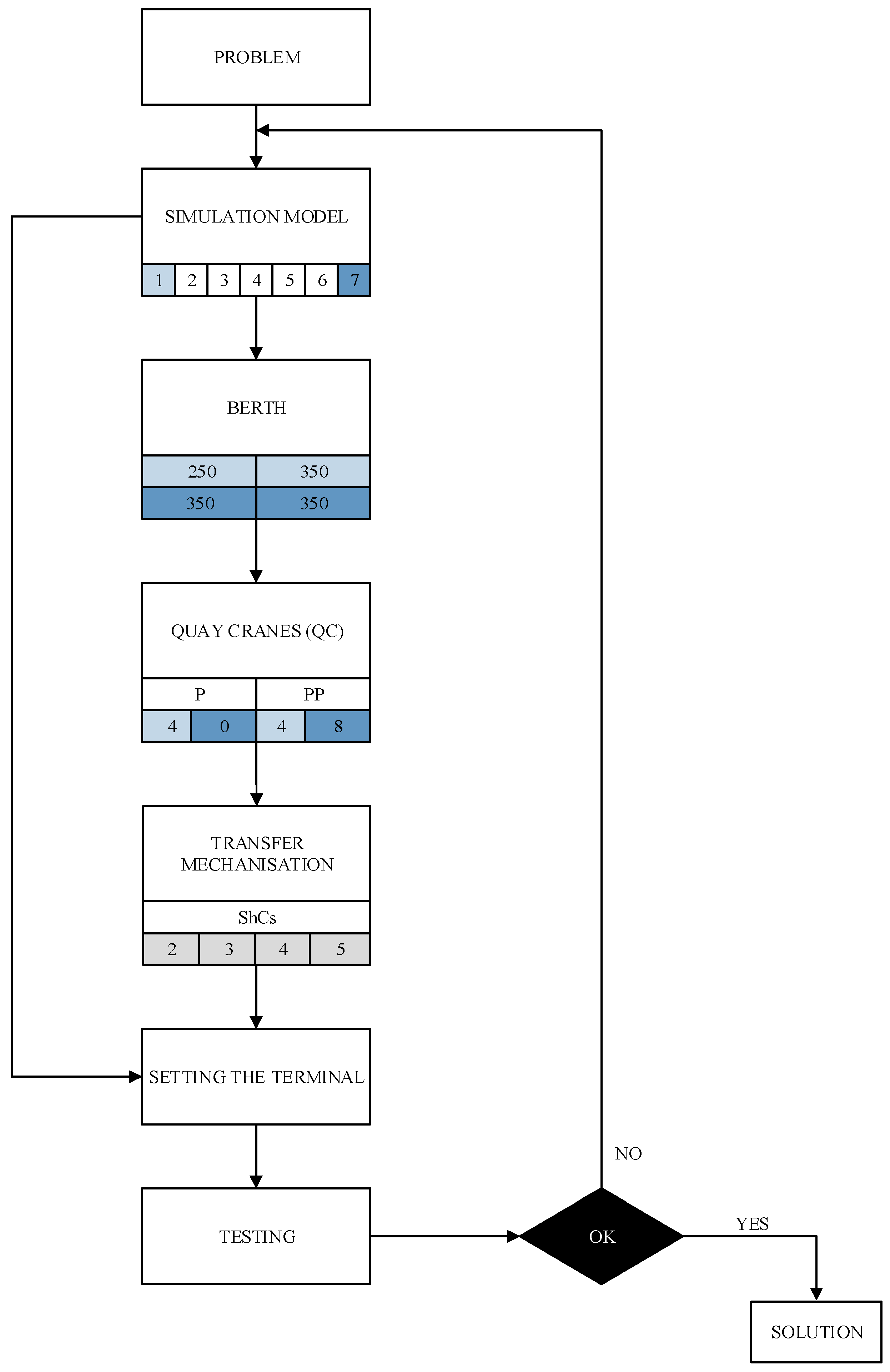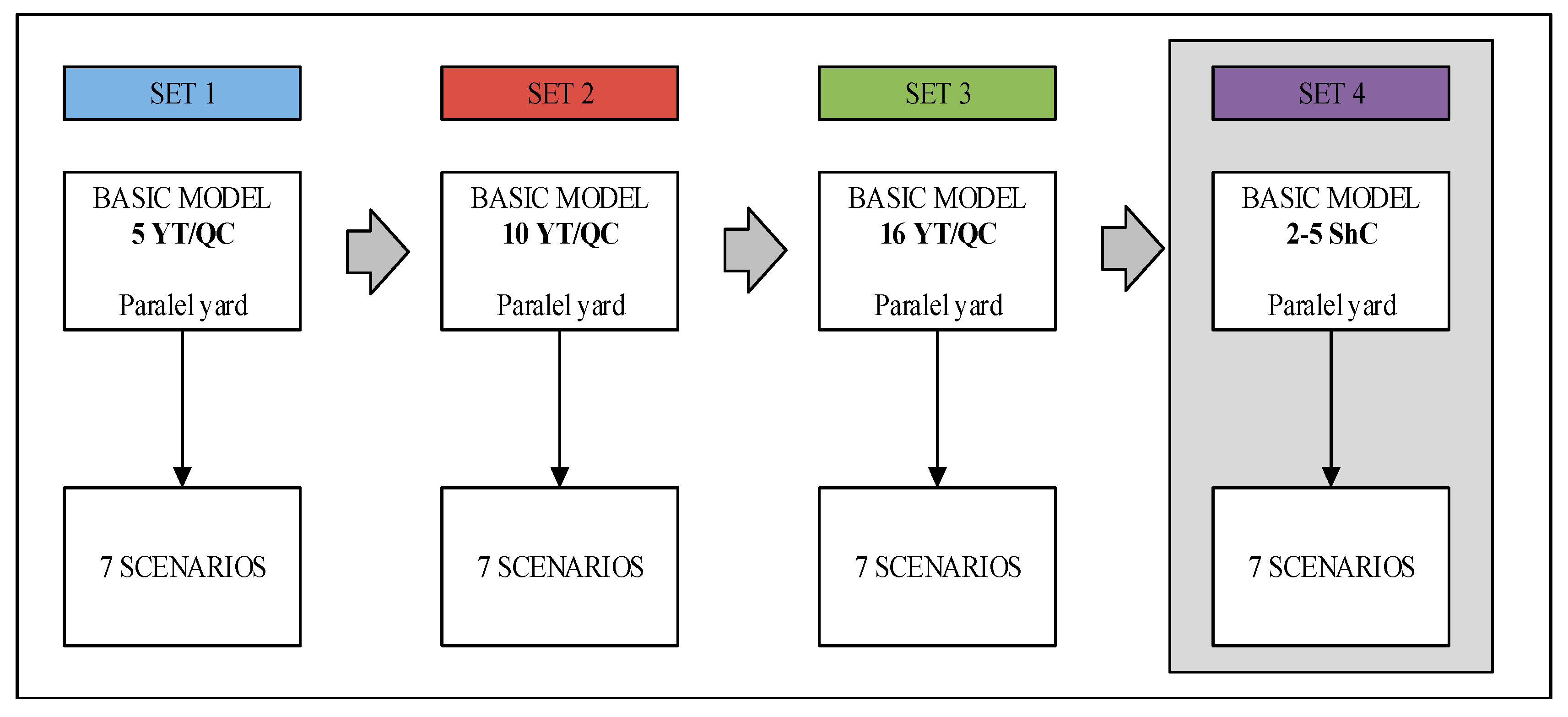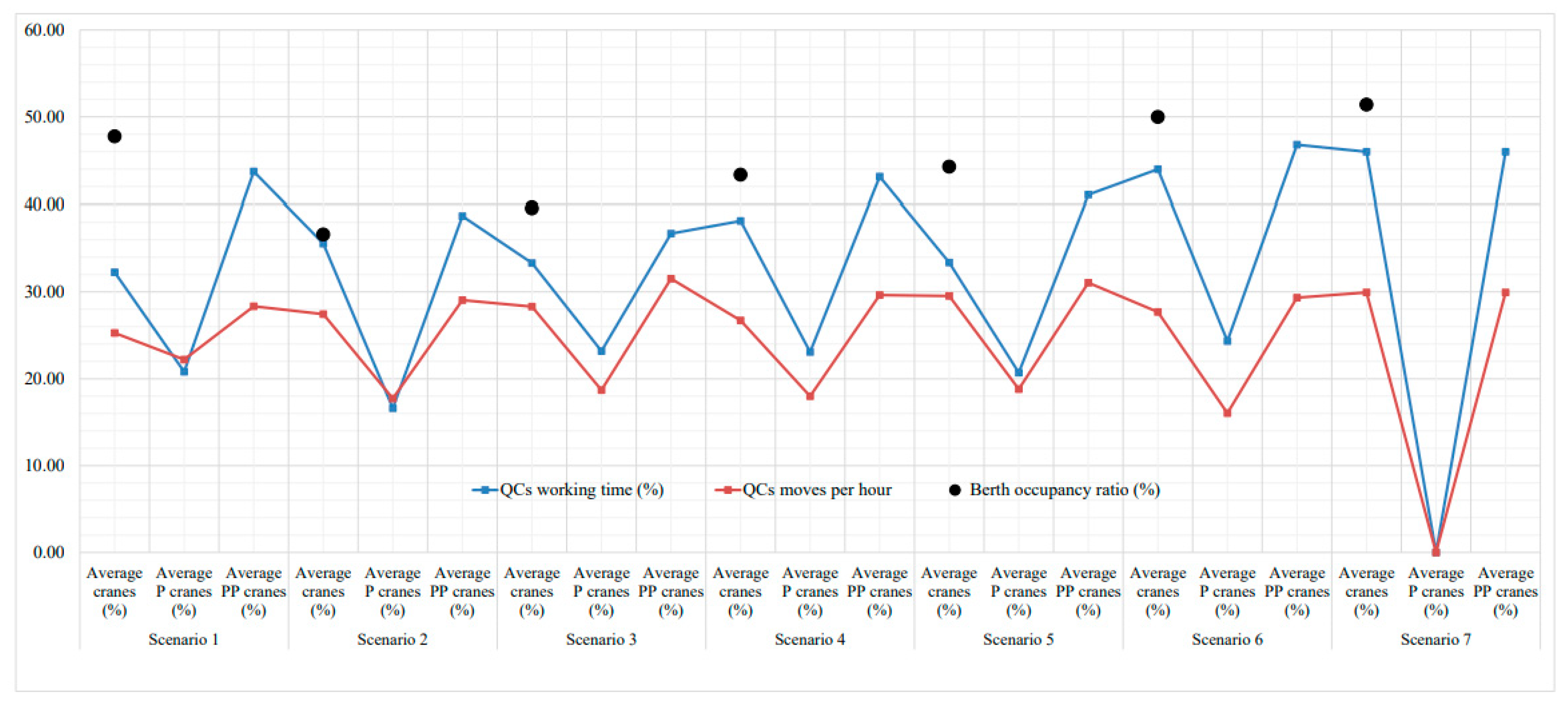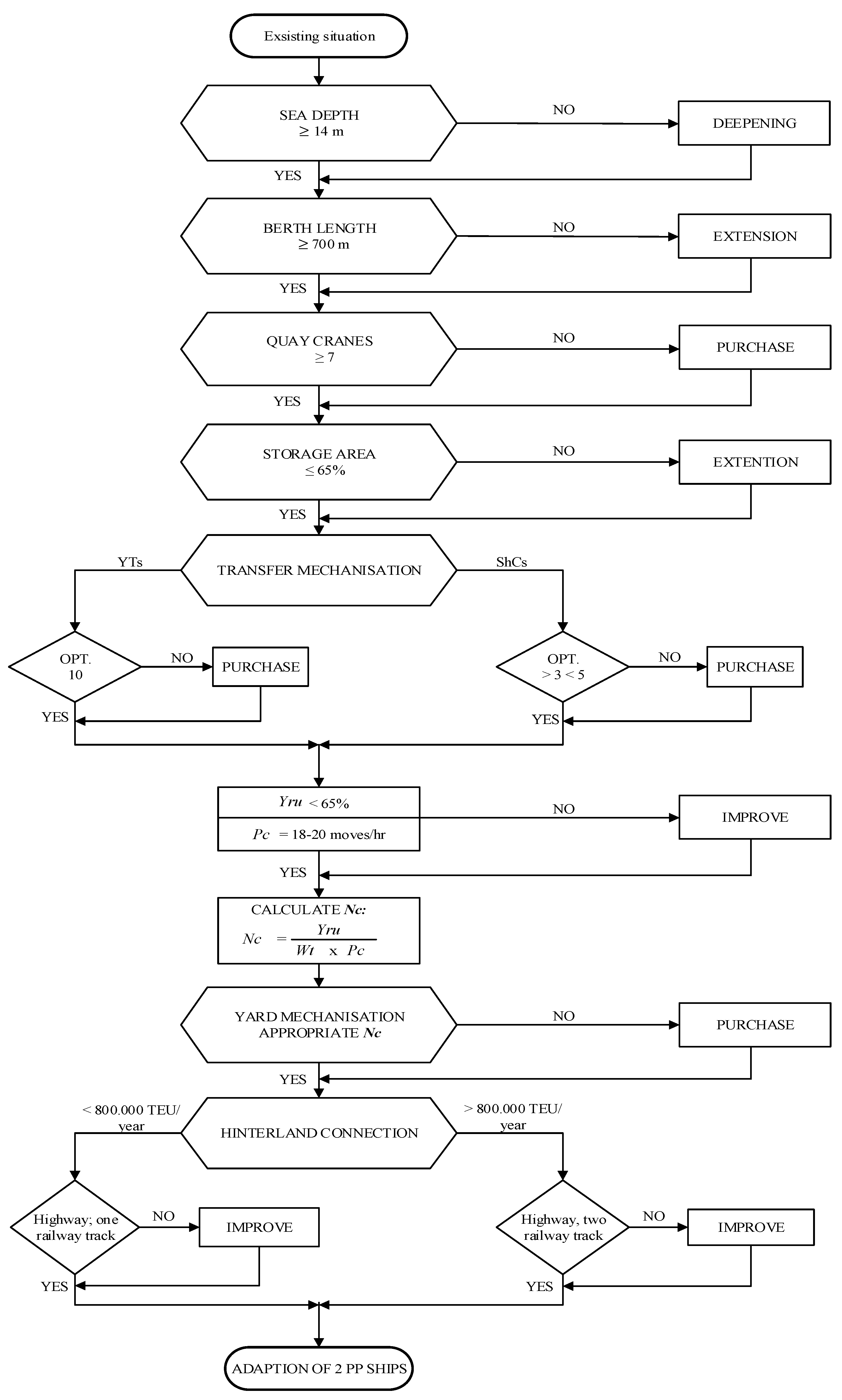A Simulation Approach to the Definition of the Subsystems Parameters in Small Container Terminals
Abstract
:1. Introduction
- how to enable smaller container terminals to increase the annual throughput accommodating two post-Panamax ships at the same time;
- how to provide these ships with optimal berth operations to enable them to leave the port quickly.
2. Container Terminal Operations Background
2.1. Container Terminal Operations
- The unloading of containers from the ship by assigned QCs and transfer to transfer mechanization;
- The transfer of containers to the yard and handing them to the YC for positioning at the assigned slot;
- The return of the transfer mechanization to the berth to pick up another container or transport another container ready for loading to the berth.
2.2. Container Terminal Simulations
3. Simulation Optimization Approach and Methodology
3.1. Simulation Model
3.2. Simulation Experiments and Methodology
4. Results
5. Interpretation of Results and Discussion
6. DST (Decision Support Tool)
7. Conclusions
Author Contributions
Funding
Institutional Review Board Statement
Informed Consent Statement
Data Availability Statement
Conflicts of Interest
References
- Sys, C.; Blauwens, G.; Omey, E.; Van De Voorde, E.; Witlox, F. In Search of the Link between Ship Size and Operations. Transp. Plan. Technol. 2008, 31, 435–463. [Google Scholar] [CrossRef] [Green Version]
- Cullinane, K.; Khanna, M. Economies of Scale in Large Container Ships. J. Transp. Econ. Policy 1999, 33, 185–207. [Google Scholar]
- Imai, A.; Nishimura, E.; Papadimitriou, S. Marine container terminal configurations for efficient handling of mega-containerships. Transp. Res. Part E Logist. Transp. Rev. 2013, 49, 141–158. [Google Scholar] [CrossRef]
- Merk, O.; Busquet, B.; Aronietis, R. The Impact of Mega-Ships. OECD. 2015, p. 108. Available online: https://link.springer.com/article/10.1057/s41278-019-00136-4 (accessed on 17 September 2021).
- Martin, J.; Martin, S.; Pettit, S. Container ship size and the implications on port call workload. Int. J. Shipp. Transp. Logist. 2015, 7, 553. [Google Scholar] [CrossRef]
- Park, N.K.; Suh, S.C. Tendency toward Mega Containerships and the Constraints of Container Terminals. J. Mar. Sci. Eng. 2019, 7, 131. [Google Scholar] [CrossRef] [Green Version]
- Shi, B.; Liu, D.; Peter, T.-J.; Wong, K.M. Overview of the development of ultra large container carriers: Where next? In Proceedings of the Boxship 2006 Conference, Shanghai, China, 5–6 December 2006; p. 10. [Google Scholar]
- Tran, N.K.; Haasis, H.-D. An empirical study of fleet expansion and growth of ship size in container liner shipping. Int. J. Prod. Econ. 2015, 159, 241–253. [Google Scholar] [CrossRef]
- Ge, J.; Zhu, M.; Sha, M.; Notteboom, T.; Shi, W.; Wang, X. Towards 25,000 TEU vessels? A comparative economic analysis of ultra-large containership sizes under different market and operational conditions. Marit. Econ. Logist. 2019, 1–28. [Google Scholar] [CrossRef]
- Stojaković, M.; Twrdy, E. Determining the optimal number of yard trucks in smaller container terminals. Eur. Transp. Res. Rev. 2021, 13, 1–12. [Google Scholar] [CrossRef]
- Vis, I.F.A.; De Koster, R. Transshipment of containers at a container terminal: An overview. Eur. J. Oper. Res. 2003, 147, 1–16. [Google Scholar] [CrossRef]
- Steenken, D.; Voß, S.; Stahlbock, R. Container terminal operation and operations research—A classification and literature review. OR Spectr. 2004, 26, 3–49. [Google Scholar] [CrossRef]
- Günther, H.-O.; Kim, K.H. Container treminals and Automated transport systems; Günther, H.-O., Kim, K.H., Eds.; Springer Science and Business Media: Berlin, Germany, 2005; p. 379. [Google Scholar]
- Murty, K.G.; Liu, J.; Wan, Y.-w.; Linn, R. A decision support system for operations in a container terminal. Decis. Support Syst. 2005, 39, 309–332. [Google Scholar] [CrossRef]
- Stahlbock, R.; Voß, S. Operations research at container terminals: A literature update. OR Spectr. 2008, 30, 1–52. [Google Scholar] [CrossRef]
- Stojaković, M.; Twrdy, E. A decision support tool for container terminal optimization within the berth subsystem. Transport 2016, 31, 29–40. [Google Scholar] [CrossRef] [Green Version]
- Meng, Q.; Weng, J.; Suyi, L. Impact Analysis of Mega Vessels on Container Terminal Operations. Transp. Res. Procedia 2017, 25, 187–204. [Google Scholar] [CrossRef]
- Zhang, H.; Kim, K.H. Maximizing the number of dual-cycle operations of quay cranes in container terminals. Comput. Ind. Eng. 2009, 56, 979–992. [Google Scholar] [CrossRef]
- Böse, J.W. Handbook of Terminal Planning; Böse, J.W., Ed.; Springer Science and Business Media: Berlin/Heidelberg, Germany, 2011; Volume 49, p. 437. [Google Scholar]
- Hervás-Peralta, M.; Poveda-Reyes, S.; Molero, G.D.; Santarremigia, F.E.; Pastor-Ferrando, J.-P. Improving the Performance of Dry and Maritime Ports by Increasing Knowledge about the Most Relevant Functionalities of the Terminal Operating System (TOS). Sustainability 2019, 11, 1648. [Google Scholar] [CrossRef] [Green Version]
- Bierwirth, C.; Meisel, F. A survey of berth allocation and quay crane scheduling problems in container terminals. Eur. J. Oper. Res. 2010, 202, 615–627. [Google Scholar] [CrossRef]
- Imai, A.; Sun, X.; Nishimura, E.; Papadimitriou, S. Berth allocation in a container port: Using a continuous location space approach. Transp. Res. Part B Methodol. 2005, 39, 199–221. [Google Scholar] [CrossRef] [Green Version]
- Jin, Z.; Li, N. Optimization of Quay Crane Dynamic Scheduling Based on Berth Schedules in Container Terminal. J. Transp. Syst. Eng. Inf. Technol. 2011, 11, 58–64. [Google Scholar] [CrossRef]
- Zeng, Q.; Yang, Z. Integrating simulation and optimization to schedule loading operations in container terminals. Comput. Oper. Res. 2009, 36, 1935–1944. [Google Scholar] [CrossRef]
- Bartošek, A.; Marek, O. Quay Cranes in Container Terminals. Trans. Transp. Sci. 2013, 6, 9–18. [Google Scholar] [CrossRef] [Green Version]
- Zhao, W.; Goodchild, A.V. Using the truck appointment system to improve yard efficiency in container terminals. Marit. Econ. Logist. 2013, 15, 101–119. [Google Scholar] [CrossRef]
- Singgih, I.K.; Kim, K.H. Flexible Load Sequencing in Container Terminals. J. Korean Soc. Supply Chain Manag. 2016, 16, 93–104. [Google Scholar]
- Stojaković, M.; Twrdy, E. The Influence of Yard Trucks on Berth Operations in Smaller Container Terminals. Sci. J. Marit. Res. 2019, 33, 171–175. [Google Scholar] [CrossRef]
- Hu, H.; Chen, X.; Zhen, L.; Ma, C.; Zhang, X. The Joint quay crane scheduling and block allocation problem in container terminals. IMA J. Manag. Math. 2018, 30, 51–75. [Google Scholar] [CrossRef]
- Brinkmann, B. Operations System of Container Terminals: A Compendious Overview. In Handbook of Terminal Planning; Bose, J.W., Ed.; Springer Science and Business Media, LLC: New York, NY, USA, 2011; pp. 25–39. [Google Scholar]
- Carlo, H.J.; Vis, I.F.A.; Roodbergen, K.J. Transport operations in container terminals: Literature overview, trends, research directions and classification scheme. Eur. J. Oper. Res. 2014, 236, 1–13. [Google Scholar] [CrossRef]
- Zeng, Q.; Yang, Z.; Lai, L. Models and algorithms for multi-crane oriented scheduling method in container terminals. Transp. Policy 2009, 16, 271–278. [Google Scholar] [CrossRef]
- Kim, K.; Lee, K.; Hwang, H. Sequencing delivery and receiving operations for yard cranes in port container terminals. Int. J. Prod. Econ. 2003, 84, 283–292. [Google Scholar] [CrossRef]
- Tang, G.; Qin, M.; Zhao, Z.; Yu, J.; Shen, C. Performance of peak shaving policies for quay cranes at container terminals with double cycling. Simul. Model. Pract. Theory 2020, 104, 102129. [Google Scholar] [CrossRef]
- Kress, D.; Meiswinkel, S.; Pesch, E. Straddle carrier routing at seaport container terminals in the presence of short term quay crane buffer areas. Eur. J. Oper. Res. 2019, 279, 732–750. [Google Scholar] [CrossRef]
- Chen, L.; Langevin, A.; Lu, Z. Integrated scheduling of crane handling and truck transportation in a maritime container terminal. Eur. J. Oper. Res. 2013, 225, 142–152. [Google Scholar] [CrossRef]
- Dragović, B.; Tzannatos, E.; Park, N.K. Simulation modelling in ports and container terminals: Literature overview and analysis by research field, application area and tool. Flex. Serv. Manuf. J. 2017, 29, 4–34. [Google Scholar] [CrossRef]
- Kotachi, M.; Rabadi, G.; Obeid, M.F. Simulation Modeling and Analysis of Complex Port Operations with Multimodal Transportation. Procedia Comput. Sci. 2013, 20, 229–234. [Google Scholar] [CrossRef] [Green Version]
- Sislioglu, M.; Celik, M.; Ozkaynak, S. A simulation model proposal to improve the productivity of container terminal operations through investment alternatives. Marit. Policy Manag. 2018, 46, 156–177. [Google Scholar] [CrossRef]
- Longo, F.; Huerta, A.; Nicoletti, L. Performance Analysis of a Southern Mediterranean Seaport via Discrete-Event Simulation. J. Mech. Eng. 2013, 59, 517–525. [Google Scholar] [CrossRef]
- Yang, Z.; Li, C.; Zhao, Q. Dynamic Time Estimation Based AGV Dispatching Algorithm in Automated Container Terminals. In Proceedings of the Chinese Control Conference (CCC), Wuhan, China, 25–27 July 2018. [Google Scholar]
- Pirhonen, J. Automated Shuttle Carrier Concept. In Handbook of Terminal Planning; Jurgen, B.W., Ed.; Springer Science and Business Media, LLC: New York, NY, USA, 2011; pp. 41–59. [Google Scholar]
- Said, G.A.E.-N.A.; El-Horbaty, E.-S.M. A simulation modeling approach for optimization of storage space allocation in container terminal. Inf. Syst. Control Eng. 2015, 9, 168–173. [Google Scholar]
- Said, G.A.E.-N.A.; Mahmoud, A.M.; El-Horbaty, E.-S.M. Solving container terminals problems using computer-based modeling. Int. J. Comput. Sci. Eng. (IJCSE) 2014, 3, 91–100. [Google Scholar]







| Scenario | Annual Throughput (TEU) | Quay (m) | QCs | No. of Feeder and Panamax Services | No. of post-Panamax Services |
|---|---|---|---|---|---|
| 1 | 630,000 | 600 | 4 P + 4 PP | 9 | 4 |
| 2 | 630,000 | 700 | 2 P + 6 PP | 9 | 4 |
| 3 | 689,000 | 700 | 2 P + 6 PP | 7 | 5 |
| 4 | 768,000 | 700 | 2 P + 6 PP | 6 | 6 |
| 5 | 844,000 | 700 | 1 P + 7 PP | 5 | 7 |
| 6 | 899,000 | 700 | 1 P + 7 PP | 5 | 7 (higher throughput) |
| 7 | 990,000 | 700 | 0 P + 8 PP | 4 | 7 (higher throughput) |
| Scenarios | QCs Working Time (%) | QCs Moves per Hour | Berth Occupancy Ratio (%) | Average Yard Utilisation (%) | YCs Average Waiting Time (min) | ||
|---|---|---|---|---|---|---|---|
| P | PP | P | PP | / | / | / | |
| Scenario 1 | 20.81 | 43.71 | 22.21 | 28.34 | 47.75 | 44.67 | 3.78 |
| Scenario 2 | 16.60 | 38.71 | 17.72 | 29.05 | 36.61 | 44.81 | 4.56 |
| Scenario 3 | 23.19 | 36.71 | 18.69 | 31.52 | 39.60 | 47.71 | 4.39 |
| Scenario 4 | 23.07 | 43.13 | 17.99 | 29.64 | 43.34 | 47.75 | 4.78 |
| Scenario 5 | 20.70 | 41.06 | 18.80 | 31.06 | 44.27 | 49.25 | 5.60 |
| Scenario 6 | 24.33 | 46.79 | 16.04 | 29.34 | 49.98 | 56.95 | 7.99 |
| Scenario 7 | 0.00 | 45.98 | 0.00 | 29.93 | 51.40 | 54.09 | 6.79 |
Publisher’s Note: MDPI stays neutral with regard to jurisdictional claims in published maps and institutional affiliations. |
© 2021 by the authors. Licensee MDPI, Basel, Switzerland. This article is an open access article distributed under the terms and conditions of the Creative Commons Attribution (CC BY) license (https://creativecommons.org/licenses/by/4.0/).
Share and Cite
Stojaković, M.; Twrdy, E. A Simulation Approach to the Definition of the Subsystems Parameters in Small Container Terminals. J. Mar. Sci. Eng. 2021, 9, 1023. https://doi.org/10.3390/jmse9091023
Stojaković M, Twrdy E. A Simulation Approach to the Definition of the Subsystems Parameters in Small Container Terminals. Journal of Marine Science and Engineering. 2021; 9(9):1023. https://doi.org/10.3390/jmse9091023
Chicago/Turabian StyleStojaković, Maja, and Elen Twrdy. 2021. "A Simulation Approach to the Definition of the Subsystems Parameters in Small Container Terminals" Journal of Marine Science and Engineering 9, no. 9: 1023. https://doi.org/10.3390/jmse9091023






